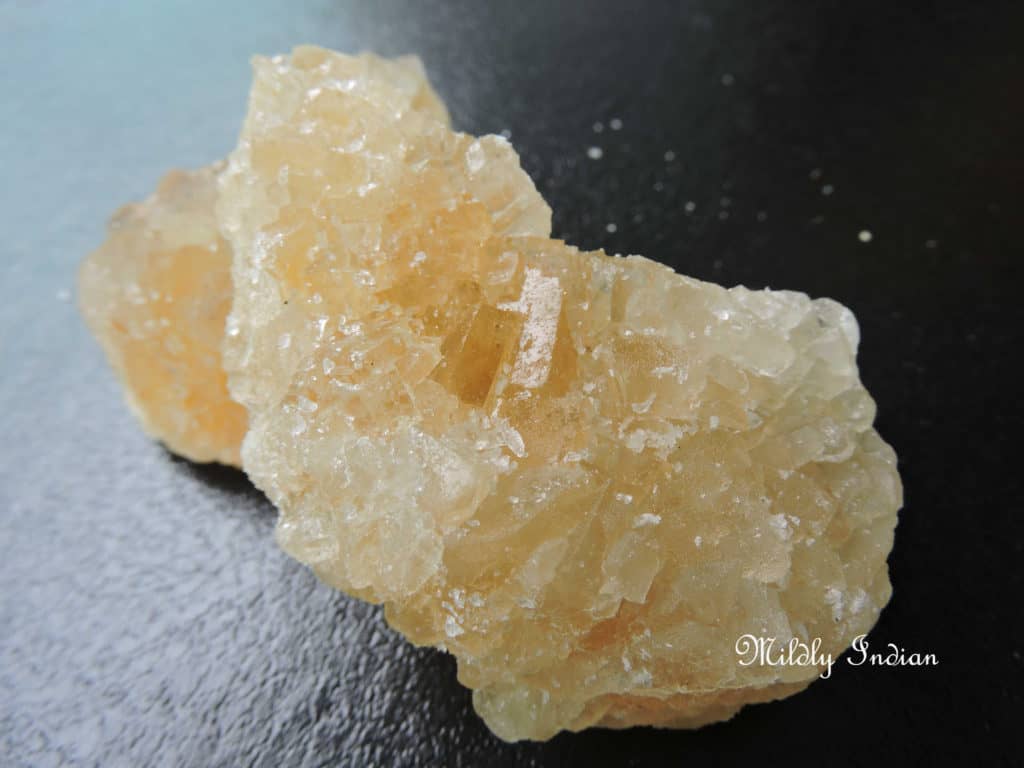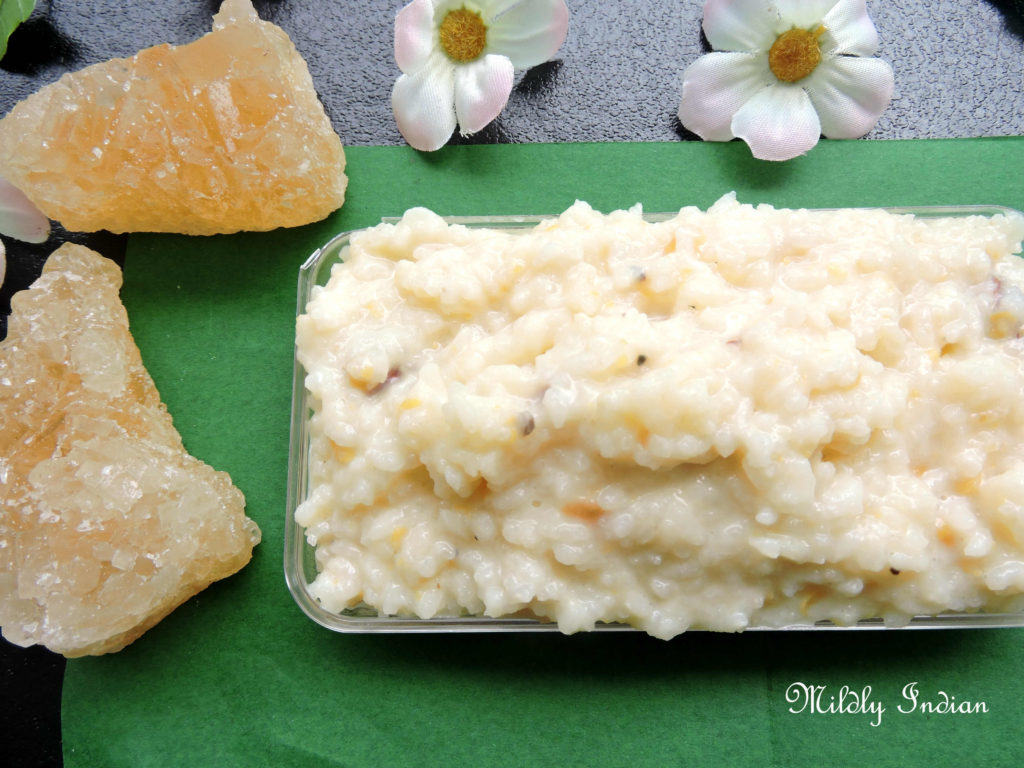Topped with plump ghee roasted raisins, the kalkandu pongal is a unique dessert made as a naivedyum. Soft-cooked, gluten-free, sweet dessert is a favourite for its gentle sweetness and temple feel. Are you ready to try this rock-sugar pudding?
What is kalkandu pongal?
Kalkandu pongal is a popular offering in a few temples near Tamilnadu. The simple mix of white rice and moong dal, sweetened with rock sugar and flavoured with cardamom saffron and edible camphor forms a delightful dessert. This is topped with ghee-roasted plump raisins and served in small palm leaf bowls called donnai.
How is kalkandu pongal different from kalkandu saadam?
On your travels through Coimbatore, don’t miss trying a version of kalkandu pongal called kalkandu saadam. This is not very different but in kalakandu saadam the rice mix is cooked in milk. This adds a good flavour and softness to the recipe. Powdered rock sugar is added in at the end and stored in the mix. This is often made at home and is called kalkandu saadam.
What is kalkandu?
Kalkandu or rock sugar is crystallised sugar. This is either of sugar cane origin or palm origin. The former called just kalkandu or misri and the latter called panam kalkandu. Now to the fact, this still is just sugar. Most Asian cuisines associate rock sugar with body cooling, however, this cannot be authenticated. To taste, it is as good as sugar.

Ingredients to make Kalkandu pongal
Rice: the short-grain white rice is best to make this recipe. Raw rice varieties like Sona masoori, Surati kolam or Thanjavoor ponni give a soft consistency. You can use basmathi if none is available.
Green gram dal: split and peeled mung bean or green gram is pasiparippu or moong dal. These yellow cotyledons are added to the rice for cooking. Unlike venpongal, the moong dal need not be roasted in this recipe.
Rock sugar: this gives a sweet flavour to the kalkandu pongal. Rock sugar can be purchased as bigger rocks or diamond-shaped kalkandu crystals. It does not matter what type you pick up as both will taste the same. The panamkalkandu or the one with palm origin appears a bit brown than the white crystals that you commonly see.
Flavouring agents: the flavour profile of this pongal is enhanced by powdered cardamom, crushed saffron and most importantly a very small pinch of edible camphor or pachai kalpooram. The edible camphor is not the camphor that is used as incense rather is available separately in speciality stores. You don’t want to add more as it is bitter, but the tiniest amount gives the best fragrance reminding one of temple prasadam.
Green gram dal: split and peeled mung bean or green gram is pasiparippu or moong dal. These yellow cotyledons are added to the rice for cooking. Unlike venpongal, the moong dal need not be roasted in this recipe.
Rock sugar: this gives a sweet flavour to the kalkandu pongal. Rock sugar can be purchased as bigger rocks or diamond-shaped kalkandu crystals. It does not matter what type you pick up as both will taste the same. The panamkalkandu or the one with palm origin appears a bit brown than the white crystals that you commonly see.
Flavouring agents: the flavour profile of this pongal is enhanced by powdered cardamom, crushed saffron and most importantly a very small pinch of edible camphor or pachai kalpooram. The edible camphor is not the camphor that is used as incense rather is available separately in speciality stores. You don’t want to add more as it is bitter, but the tiniest amount gives the best fragrance reminding one of temple prasadam.
Ghee: the perfect soft consistency is the magic of the water sugar and ghee combination. So you do need a bit of ghee to get this recipe ready. Use natural cowmilk ghee. Ghee is nothing but clarified butter and is an excellent medium to cook warm desserts with. It appears golden yellow and solidifies in winter.
Ghee-plumped raisins: raisins roasted in ghee are an add-on to this recipe. It is not an essential ingredient to this recipe, but a nice touch to add to the sweetness.
Let’s make kalkandu pongal
The rock sugar pudding recipe happens in a couple of steps.
Cook the rice dal mix: the rice and moong dal are mixed and washed about 3 to 4 times till the water runs clear. Then pressure cook this mix with excess water to a soft consistency. If using an instant pot, this can be set at normal pressure for 13 minutes and it will be ready. Once the pressure is naturally released, remove the lid and carefully mix the cooked mix.
Cook the rice dal mix: the rice and moong dal are mixed and washed about 3 to 4 times till the water runs clear. Then pressure cook this mix with excess water to a soft consistency. If using an instant pot, this can be set at normal pressure for 13 minutes and it will be ready. Once the pressure is naturally released, remove the lid and carefully mix the cooked mix.
Prep the kalkandu: The rock sugar in big chunks will have to be broken down into small bits. then powdered or crushed so that it is easy to dissolve.
Combine to make the rock sugar pudding: Add the powdered rock sugar to the cooked rice dal mix. Add the ghee at this stage. This will make the pongal more liquid. Keep gentle simmer and constant mixing. Add the aromatics and the Pongal is ready when it forms a semi-solid consistency.
Ghee plumped raisin topping: in a small quantity of ghee roast about 10 raisins till they become very plump. dd this along with the ghee to the top of the pongal.
When to make kalkandu pongal?
Kalkandu pongal is very special to make during most festivals. This is best made during Navratri, Pongal, Tamil Puthandu or Krishna Jayanthi. It is an easy recipe for naivedyam and can be shared with friends and family in a donnai or small bowls.

Kalkandu Pongal
Topped with plump ghee roasted raisins, the kalkandu pongal is a unique dessert made as a naivedyum. Soft-cooked, gluten-free, sweet dessert is a favourite for its gentle sweetness and temple feel. Are you ready to try it?
Equipment
- Pressure cooker or instant pot
Ingredients
To pressure cook
- 1/2 cup Raw rice Short grain
- 1/2 cup Moong dal ( green gram dal, pasiparippu, cheruparippu, heserubele)
- 3.5 cups drinking water
To add after pressure cooking
- 1 cup rock candy crushed rock sugar
- 2 tbsp ghee / clarified butter
for the aroma
- 2 pods green cardamom
- 2-3 strands saffron
- 1 pinch edible camphor
for the ghee roasted raisin topping
- 1 tbsp raisins
- 1 tsp ghee
Instructions
- In a pressure cooker pan set to medium heat roast the moong dal till aromatic
- Add the rice, followed by water and mix well
- Pressure cook the combo for about three to five whistles.
- Once the pressure is released open the pressure cooker and set it on a simmer.
- Add in the rock sugar and mix well.
- Gently mash as you go along and simmer. Make sure it doesnt catch the bottom
- Add the crushed cardamom pod, saffron and edible camphor and mix well
- Add boiled water if the pongal becomes too thick.
- In a small pan add the ghee, nut and th raisins. Roast till the raisins are puffy and add to the simmering pongal
- Stir and its ready to serve
Tried this recipe?Let us know how it was!
A few pongal recipes to try
Here are a few different sweet pongal recipes that you may like to attempt during the festival seasons.
Sugarcane and aval pongal
Jackfruit pongal
Palm jaggery pongal
Millet pongal
Sugarcane and aval pongal
Jackfruit pongal
Palm jaggery pongal
Millet pongal
Stay connected
Hope you enjoy making this unique pongal recipe. When you do share with us in comments how you likes it and if it is a yes, rate us with the five stars.
Wish you a happy festival season.
Pin for later
See you at the next post.
Wish you a happy festival season.
Pin for later
See you at the next post.






Seema, this Kalkandu Pongal is what I will be trying this Sankranti. I have heard a lot about it, and I am sure FIL will like it a lot soft, semi-solid rice is what he prefers these days.
I am so glad you will try it, Archana. It is a great soft-cooked recipe for the elderly too during the festive season.
Quite an impressive traditional pudding with rock sugar. I am yearning to try it. Looks quite creamy and filling.
Please do give it a go. It is not as sweet as a kheer, but is creamy enough with just the ingredients.
I very much enjoy reading about some traditional foods especially those that are cooked at temples for offering. Kalkandu pongal is an interesting preparation and am sure our forefathers knew the benefits of using rock sugar.
I am sure our forefathers did find a way to purify the sugar cane juice and the crystals would have been considered superior to the brown jaggery.
too yum!! I love this more than the classic Chakkara Pongal. Pati used to make this for Koodaravalli or bhogi I also follow that tradition 🙂
Goood to know about this recipe. Interesting version of Pongal here Seema. I have rock candy and will use it to make this delicacy.
We love kalkandu pongal, an often made dish at home, especially after receiving huge rock candies as prasadam at perumal temple. amma makes a large quantity to distribute to everyone. Such a delight to devour. Love how you have made it exactly like my mom’s, with a pinch of edible camphor. Brilliant share
Kalkandu pongal recipe is too yummy. I liked the fact that is no milk used to make this pongal . Kalkandu saadham is cooked in milk totally and takes longer to cook .kalkandu pongal seems to be a rich and creamy variant of pongal with less work and amazing end result 🙂